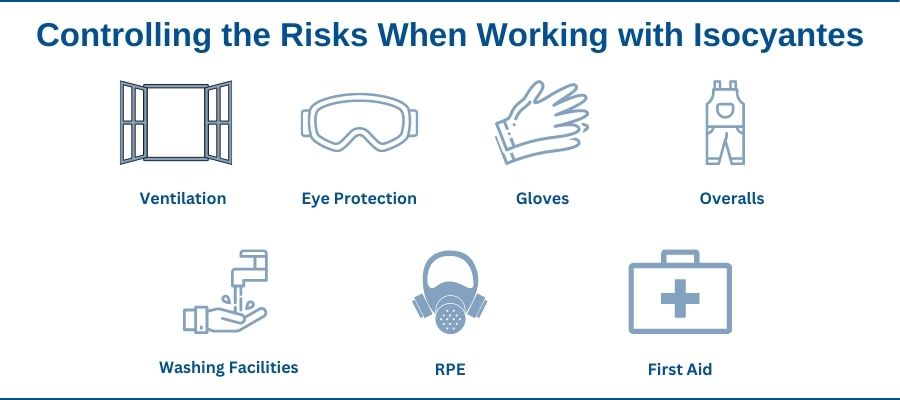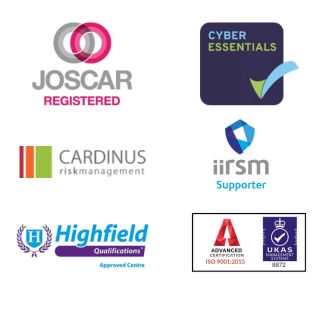New Training Requirements for those Working with Isocyantes
 As of 24 August 2023 it will become mandatory that anyone working with diisocyantes will need to have appropriate training prior to using them. The onus will be on the employer to ensure that their staff have been appropriately trained, but whilst the EU currently has training options, the Health and Safety Executive (HSE) are still planning how to manage this change and the training requirements here in the UK.
As of 24 August 2023 it will become mandatory that anyone working with diisocyantes will need to have appropriate training prior to using them. The onus will be on the employer to ensure that their staff have been appropriately trained, but whilst the EU currently has training options, the Health and Safety Executive (HSE) are still planning how to manage this change and the training requirements here in the UK.
So, Let’s back track a little and understand what materials contain isocyantes and why they are a risk.
Which Materials Contain Isocyantes?
Isocyantes can be found in many products used in the construction industry including, polyurethane paints, coatings, foams, glues and flooring. They come in various formats, MDI, TDI, HDI and IPDI – some like TDI are more volatile and have a high vapour pressure (they evaporate quickly).
How they are used is also important. For example, if used in a spray there is a higher risk to the worker and higher exposure to isocyantes.
Why is there a Risk Using Isocyantes?
Isocyantes can affect your health in a few ways:
- Irritate the eyes, nose and throat
- Cause dermatitis ( a reddening, crusting or swelling of the skin)
- Occupational asthma – this is a particular risk for those spraying isocyantes
You can find more information about these side affects on the HSE website.
How Can you Reduce the Risks of Working with Isocycantes?
Prevention is always the best way to reduce the risks. You can replace products that do not contain isocyantes or use ones that are less volatile. Try using a brush or roller where possible instead of spraying, and keep people away from isocyantes work if they are already sensitive to these products.
If you still need to use isocyantes then you will need to manage this as part of your COSHH risk assessment process, ensuring that you have identified suitable and sufficient control measures.
The HSE have a helpful list of 7 ways to control and minimise the risks.
- Ventilation – open doors and windows to make sure there is enough fresh air. Depending on the risk, mechanical ventilation may be required.
- Eye Protection – Ensure eye protection is worn to avoid aerosol getting into the eyes.
- Gloves – Protect hands by making sure the right gloves are worn for the product being aware of breakthrough time and permeation rate. Think about the type and length of work. Wear single use disposable nitrile gloves or gauntlet style gloves as necessary.
- Overalls – Wear disposable overalls where possible, or ensure reusable overalls are washed if contaminated.
- Washing – Ensure access to appropriate washing facilities so that any product that gets on the skin can be washed of as quickly as possible. Exposed skin should be washed during breaks and once work is completed.
- Respiratory Protective Equipment (RPE) – If ventilation is inadequate then RPE should be worn. This is especially important in enclosed spaces if you are rollering and creating an aerosol. Don’t forget, masks should be fit tested.
- First Aid – Make sure appropriate first aid treatment is given to anyone affected by isocyantes.
Mandatory Training When Using Isocyantes
The new legislation coming into force this August means that training will be mandatory for anyone using isocyantes. It will be the employer’s responsibility to ensure that workers have appropriate training, but as mentioned above the HSE are still working out the training requirements for here in the UK.
If your business operates within the EU, training levels have already been decided and are as follows:
Level 1: General training (mandatory for all users of isocyantes)
Level 2: Intermediate training (e.g for polyurethane adhesives, floor coatings, waterproofing)
Level 3: Advanced training (e.g Paints and coatings that are not sprayed or open handling hot and warm formulation at 45°C)
In order to do Level 2 or 3 training, Level 1 training must first be completed as it forms the platform for all the training levels.
Source: European Coatings
Sureteam Will Support Your UK Business
For now, if your business operates within the UK, it is important to be aware of the legislative changes coming into force. Once the HSE announces the training requirements here, Sureteam will be able to provide the appropriate training based on the REACH requirements, so that we can continue to support our clients maintain safe and compliant working practices.
If you’d like to hear when our new training will be available let us know your contact details and we will be in touch with you nearer the time.
* This restriction was adopted on 4 August 2020 under the EU REACH regulations. After Brexit, this regulation was brought into UK law (21 January 2021) and known as UK REACH. The restriction on diisocyantes (EU 2020/1149) was carried over to UK legislation unchanged from EU one but was subsequently modified in September 2021 making the restriction only operable for companies within Great Britain.
Further reading:
HSE – https://www.hse.gov.uk/construction/healthrisks/hazardous-substances/isocyanates.htm







